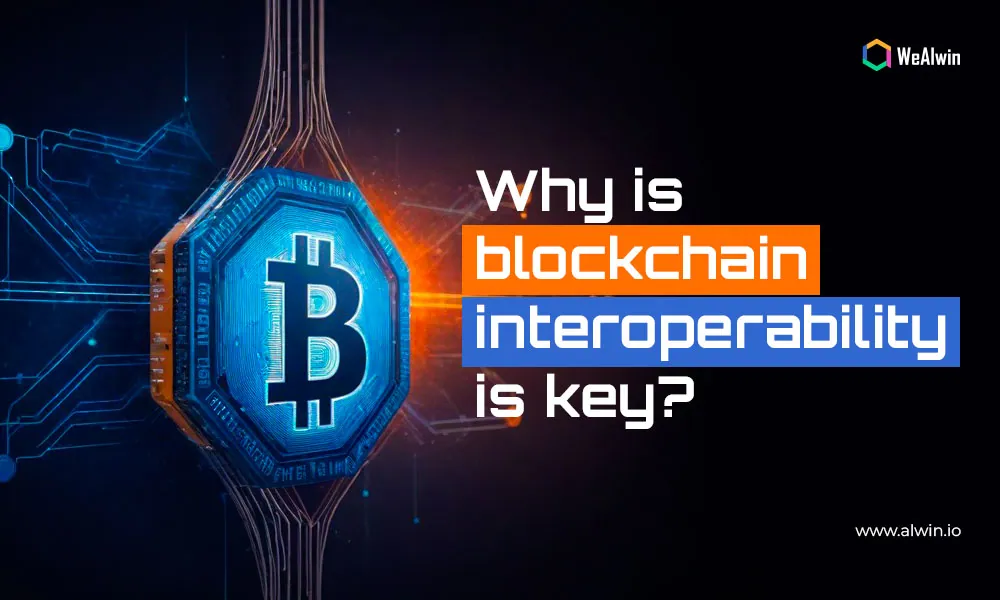Our Products
Our Services
Our Company
Newsletter
© 2024 WeAlwin Technologies Pvt Ltd.All Rights Reserved

In the unimagined digital world, digital transactions reign supreme in the blockchain industry. However, the challenge of the blockchain landscape poses a significant hurdle to facilitating seamless transactions between blockchain networks. Fortunately, blockchain interoperability offers a solution to this issue.
Blockchain interoperability allows different blockchains to communicate, share digital assets, and work together effectively, enabling the exchange of data and assets across networks.
Blockchain interoperability is crucial for the mass adoption of blockchain technology due to the diverse nature of data and assets within the crypto ecosystem. As new blockchain networks emerge to cater to specific niches in various industries, each with specialized functions, interoperability becomes essential.
For example, we are going to do a Cross-Chain Asset Transfer
Imagine Alice wants to send a token from Ethereum to Bob on the Binance Smart Chain. With blockchain interoperability, she can do it seamlessly.
Alice initiates the transfer from her Ethereum wallet.
The interoperability protocol locks the token on Ethereum and issues it on BSC.
Once confirmed on both networks, Bob receives the token on BSC.
Bob can now use the token on BSC, thanks to interoperability.
This showcases how interoperability simplifies cross-chain asset transfers, opening up new opportunities across different blockchain networks.
Interoperability lies in its ability to enhance decentralization by linking participants across multiple blockchains through a single protocol, reducing friction for users accessing decentralized applications (DApps) without the need to manage multiple tokens for different networks
It streamlines user experiences by enabling the use of one token across various blockchains and facilitates access to protocols on multiple networks with ease.
Additionally, interoperability fosters growth in the industry by improving liquidity across networks and providing traders with more opportunities to utilize their assets effectively.
To achieve blockchain interoperability, various methods are employed, including sidechains, oracles, bridges, swaps, and industrial solutions like Polkadot and Cosmos.
These tools enhance interoperability between blockchain networks by enabling the seamless transfer of assets and data across different chains. By bridging the gap between isolated blockchain ecosystems, interoperability paves the way for a more connected and efficient future in blockchain technology.
Most Layer-1 blockchains currently lack native features to facilitate cross-chain interoperability. Nevertheless, various tools are emerging to enhance interoperability between blockchain networks:
Sidechains: Operating as Layer-2 platforms, sidechains are independent blockchain networks compatible with a single mainchain. Each sidechain possesses its own consensus mechanism, security parameters, and tokens. These sidechains typically cater to specific use cases, distributing tasks to enhance overall ecosystem efficiency and autonomy. Prominent projects like Polkadot and Cosmos were purposefully developed as comprehensive cross-chain infrastructure solutions, aiming to establish an interoperable "network of networks."
Oracles: Oracles act as intermediaries between on-chain and off-chain environments within blockchain technology. Decentralized oracle services such as Chainlink and API3 bridge the gap by providing off-chain data to blockchain-based smart contracts, contributing to blockchain interoperability by ensuring different ecosystems refer to a common data source.
Bridges and Swaps: Cross-chain bridges enable digital assets to be locked on one chain while identical assets are "minted" on another chain and transferred to the original owner's address. In contrast, atomic swaps allow users to exchange tokens across different blockchain networks in a decentralized manner. Both mechanisms operate automatically through smart contracts, playing a pivotal role in facilitating seamless cross-chain value transfers.
1. Overcoming Fragmentation
One of the primary reasons why blockchain interoperability is paramount lies in its ability to overcome the fragmentation that plagues the blockchain ecosystem. With thousands of blockchain networks in existence, each with its own set of protocols and standards, achieving seamless communication and collaboration between these disparate systems is imperative for fostering innovation and driving widespread adoption.
2. Facilitating Data Sharing
Blockchain interoperability enables seamless data sharing and transfer between different blockchain platforms, thereby breaking down silos and facilitating collaboration across industries. By ensuring compatibility between diverse networks, businesses can unlock new opportunities for data monetization, supply chain optimization, and enhanced customer experiences.
3. Mass adoption and Efficiency
Organizations can harness the scalability and efficiency benefits of multiple platforms by enabling interoperability between blockchain networks. This multi-chain approach allows for greater transaction throughput, reduced latency, and improved overall performance, paving the way for the mass adoption of blockchain technology in enterprise settings.
4. Promoting Decentralization
Interoperability is fundamental to preserving the decentralized nature of blockchain technology. By enabling seamless communication between disparate networks, blockchain interoperability fosters a more inclusive and interconnected ecosystem where no single entity holds undue control or influence. This decentralization not only enhances security and resilience but also promotes trust and transparency in the digital economy.
5. Catalyzing Innovation
Perhaps most importantly, blockchain interoperability serves as a catalyst for innovation by fostering an environment where developers can leverage the strengths of multiple blockchain platforms to create novel solutions and applications. Whether it's cross-chain decentralized finance (DeFi) protocols, interoperable non-fungible token (NFT) marketplaces, or cross-border payment networks, the possibilities are virtually limitless when barriers to interoperability are removed.
Finally, from the above exploration blockchain interoperability is not merely an additional concept it's a core concept of blockchain development; it is a fundamental enabler of the decentralized, interconnected future envisioned by blockchain proponents worldwide.
As businesses and industries continue to embrace blockchain technology, ensuring interoperability between disparate networks will be essential for realizing the full transformative potential of this revolutionary technology.